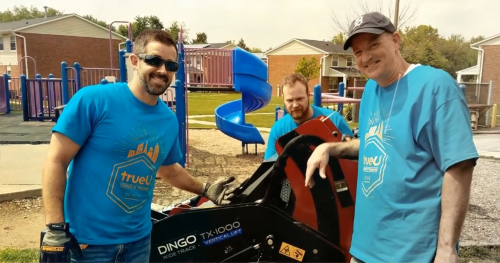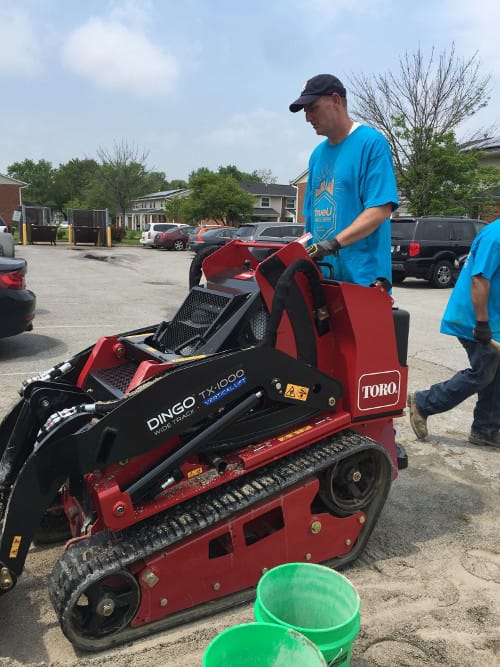Kenney Machinery Employees Build Peace Park with Help From Toro Dingo
edit[simple-social-share]

The project, which was coordinated by trueU and ProAct Indy, involved building a peace park at the Laurelwood Community, a public housing complex operated by the Indianapolis Housing Agency. You can learn more about Kenney Machinery’s long-term partnership with trueU by reading our previous blog articles on the subject.
The participating employees were Sales and Marketing Manager Kevin Koss and Controller Jon Treadway. In an interview with the Kenney Machinery blogging staff, Kevin described the event and what lessons he and Jon learned from it.
He also recounted how a Toro Dingo compact utility loader made an unexpected but very helpful contribution to the project.
Here’s the highlights of our interview with Kevin:
How is it that you were able to participate in the project at the Laurelwood Community?
All of the managers at Kenney Machinery are going through a program called Leaders in Training (LIT) with trueU, an organization that we’ve been partnering with for well over a year now. It’s a six month program that involves both classroom work and hands-on experiences where we get to put into practice the leadership principles we’ve been learning about.
The project at Laurelwood was one of those hands-on experiences, and the theme of the experience was servant leadership. For this project, trueU partnered with a local organization called ProAct Indy that collaborates with community leaders and professional organizations to provide community outreach service projects for economically disadvantaged youth in Marion County and beyond.
Their intent is that rather than merely being the recipients of community service, the youth will be the givers and creators of the projects that support the communities where they live.
There were 27 other people in the LIT program (besides myself and Jon Treadway) who participated in the project, plus about 18-20 seventh and eighth graders from a local charter school who helped out as well.
Describe the community where the project was taking place.
The Laurelwood Community is a low-rent public housing development on the south side of Indianapolis which is operated by the Indianapolis Housing Agency. In order to rent a unit in the complex, people must meet income eligibility requirements set by HUD. Ninety percent of the children living in the area are eligible for free or reduced price lunch at school.
In the past, Laurelwood was considered a dangerous and high-crime neighborhood in Indianapolis, but about 10 years ago they started partnering with local community agencies such as the Intercollegiate YMCA and the University of Indianapolis, and now the Laurelwood community has been lifted up as a national model for how to improve the conditions in similar communities.
What exactly did the project entail?
The project involved building a “peace park”, which consisted of a labyrinth and picnic tables. So, essentially, the project was to actually build the labyrinth from the ground up and assemble the picnic tables.
A labyrinth is essentially a maze-like structure that is often used to evoke metaphor or spiritual pilgrimage. They are often used in religious practice, mindfulness, environmental art, and community building. Unlike a maze, all paths in a labyrinth lead to the center, so there are no dead-ends.
The labyrinth we had to build was going to lie flat on the ground, with the “walls” consisting of 850 painted bricks embedded in the ground. The materials for the project had already been prepared and delivered to the job site, and those consisted of the bricks, pre-cut sod, and a patio base. What we had to do was paint the bricks, excavate the area where the labyrinth would go, build a sort of berm with the sod, and then fill it in with the patio base.
All of this had to be accomplished in two days, so there definitely needed to be some planning and coordination in order to complete all the tasks in the allotted time. That’s where the leadership skills we had been learning came into play.
How did your team go about completing the project?
On the first day, it was raining and storming pretty heavily in the morning, so we spent the time inside getting to know each other a little better and also getting to know the folks from ProAct Indy who were there facilitating everything.
When the weather broke, we split up into three teams—one team to paint the bricks, an excavation and fill team to dig out the area for the labyrinth, and a team to assemble and stain five brand-new picnic tables. Myself and Jon were on the excavation and fill team.
Around that time, the sun came out and it got quite hot and humid. However, because of all the rain, the patio base and mulch had soaked up a lot of moisture and was very heavy. It needed to be carried from where it had been dumped to the location of the labyrinth, and also to various playgrounds around the community. That’s when I thought to call our office and have one of the guys bring a Dingo down for us to use.
How did having the Toro Dingo help complete the project?

What was it like working with the kids from the community on the project?
I seem to get along pretty well with kids regardless of their background. I always try to find that common connection with them whether it’s sports or siblings or music or whatever, because I’m passionate about things as well, and there always seems to be a connection point there with them.
When we first did the introductions, we were all tasked with going around and seeing and talking to a minimum of three individuals for a couple minutes just to get to know them. Of course you’re trying to pull information from them because they’re not as willing and open, and they don’t know you. It’s the first time they’ve met you and again, these are seventh and eighth graders. But eventually they felt comfortable enough to start opening up more, and they contributed a lot to the project.
In fact, not only did all of the kids come back to help the second day, but there were actually a few more that weren’t even there the first day. We were told that due to some testing required by the State of Indiana, the kids might not be able to come the second day. It would basically come down to how motivated they were to complete what they needed to in the morning so that they could get back to us in the afternoon. Sure enough, they all came back, and most of them busted their tails.
It was great to see a neighborhood of people coming out and looking at what was going on in their community, and seeing that they really did have a willingness to make it better with the help of people from outside the community.
How did the event help with the trueU Leaders in Training course?
At the end of the first day, all the people from the LIT program came together and had a session where we discussed what we observed, what impacted us the most, and what we took away from the day.
The session was led by Derrin Slack from ProAct Indy, and he had a bunch of little plastic body parts like eyes, ears, feet, a heart, etc. The idea was that each person from the group would pick two or three body parts and share how that body part impacted them during the course of the day.
For example, if you picked the eyes, you could talk about something you saw, and if you picked the ears, you could talk about something you heard, and so on. It was a very effective way of taking a step back and seeing what servant leadership really looks like.
What’s coming up next in the LIT program?
In June, we will be split into two groups. One group will do a ropes course at Butler University while the other one does a classroom session. Then there is one more session in July, and it’s capped off at the end of August with a presentation that each of the groups do about what you’ve learned in the program.
Be sure to follow the Kenney Machinery blog for future updates about the trueU program, including more to come from Kevin and Jon as they finish the LIT program.

